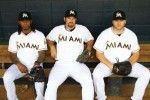A Fresh Start for the Fish

Did you know that from 2003 to 2011, the Florida Marlins (now the Miami Marlins) went exactly 729-729? This is undoubtedly the perfect stat to describe the Marlins’ last decade, because aside from their out-of-nowhere World Series run in 2003, the Marlins have been perfectly mediocre.
Want another stat from the same timeframe? Since 2003, the Marlins have had an average payroll of $39,653,000.11. In the same time period, the Yankees have compiled a record of 872-586 for an average of just under 97 wins a season while spending an average of $193,819,908 per year. If you look at it by how much each franchise spent per win during this time period, the Marlins spent about $489,543 per win while the Yankees spent $2,000,618. How many World Series titles did each franchise win in that time frame? They both won one. In many ways, the Marlins have been a more efficient franchise over the last decade than the Yankees. They’ve quietly spent just about nothing, relying on cheap, young, home-grown talent and have submitted a string of very respectable seasons.
That’s all changed. The Marlins signed free agent super shortstop Jose Reyes to a six-year/$108 million deal, veteran inning-eating starting pitcher Mark Buehrle to a four-year/$58 million deal and All-Star closer Heath Bell to a 3-year/$27 million deal. Not only that, but they were seriously engaged in talks with Albert Pujols, C.J. Wilson and Ryan Madson. Prior to this year, the Marlins would have been literally the last team anyone would have expected to be involved in talks with any of those six names. So why now? Well, one factor is pretty obvious. This season marks the unveiling of the newly-constructed, $515 million (or $2.4 billion, if you look at what the Marlins and the city will have to pay from interest on loans) Marlins Park in Miami, and the team is clearly trying to build some buzz to spur ticket sales.
Another is a little less obvious. The Marlins have a pretty talented young core and, though they only posted 72 wins in 2011, the new extra wild card slot and the National League’s general openness give them a legitimate shot at making the playoffs. Aside from the Philadelphia Phillies, who are quietly old and banged up offensively, who’s a lock for the NL playoffs right now? Arizona is positioned well for another run out West, but last year’s other two playoff teams – the St. Louis Cardinals and Milwaukee Brewers – lost a couple of guys you may have heard of named Albert Pujols and Prince Fielder. The NL is more wide open now than it has ever been.
But are these moves the right moves? The Jose Reyes signing certainly raised a lot of eyebrows from the outset. For one, the Marlins already had a young franchise shortstop in Hanley Ramirez, who’s now going to have to move to third. Though Hanley is certainly talented enough to potentially make a smooth transition, let’s not forget that this is Hanley Ramirez, the same man who has frequently ripped managers and quit on his team. Though he might be saying all the right things, it would be foolish to think that he is thrilled about the move. Not to mention that Reyes, though he’s only 28 and still may not have reached his incredibly high ceiling as a player, has played an average of 98 games the last three years. Saying he’s far from a sure thing may not be going far enough.
Then there is the Mark Buehrle move. You can’t fault the Marlins for wanting to bring in an established veteran presence who’s going to give you seven innings most nights, which Buehrle will do. That said, at what cost? $14.5 million a year? That’s a pretty steep price for a pitcher with a 4.02 ERA over his last six seasons. It seems most likely that Miami wanted Pujols and C.J. Wilson and settled for Plan B when this was no longer a possibility.
What the Miami Marlins face ahead of them is not overcoming a culture of losing but a culture of indifference. They won the World Series in 1997 and 2003 and South Florida briefly took interest in them, before forgetting soon after that they existed. They played at SunLife Stadium, an ugly, outdated monstrosity ill-suited for watching a baseball game. Funny story, I actually went to a Marlins game back in 2005. Not only was it one of their biggest promotions of the year, “Bark at the Park,” where you could bring your dog to the game for free (how exciting!), but I was treated to a masterful A.J. Burnett complete game performance. Burnett was hitting 98 miles per hour on the radar gun all night (yeah, he actually used to be good). There were 10,000 people tops, maybe a quarter of whom were actually paying attention to the game; the rest were just chit-chatting and enjoying some casual drinks. To this day, that remains the most pathetic crowd I’ve ever been a part of – well, outside of any Colgate basketball game.
The Marlins have never been a bad team, but they’ve never had a ton of star power (you could argue Ramirez has been one, but certainly not a likable one). Add that to an awful stadium in an area where people would rather hit the beach than go to a baseball game and it’s not shocking the Marlins have continued to struggle to find a core fan base. Now they’ve got a city to call home, a new stadium, a new name, new uniforms, new faces and a new limelight-loving manager in Ozzie Guillen. With the hundreds of millions of dollars the franchise has committed, the stakes have never been higher and the Marlins clearly have pushed all their chips to the center of the table. One thing’s for sure; it’s now or never for the Miami Marlins. Contact Pete Koehler at






